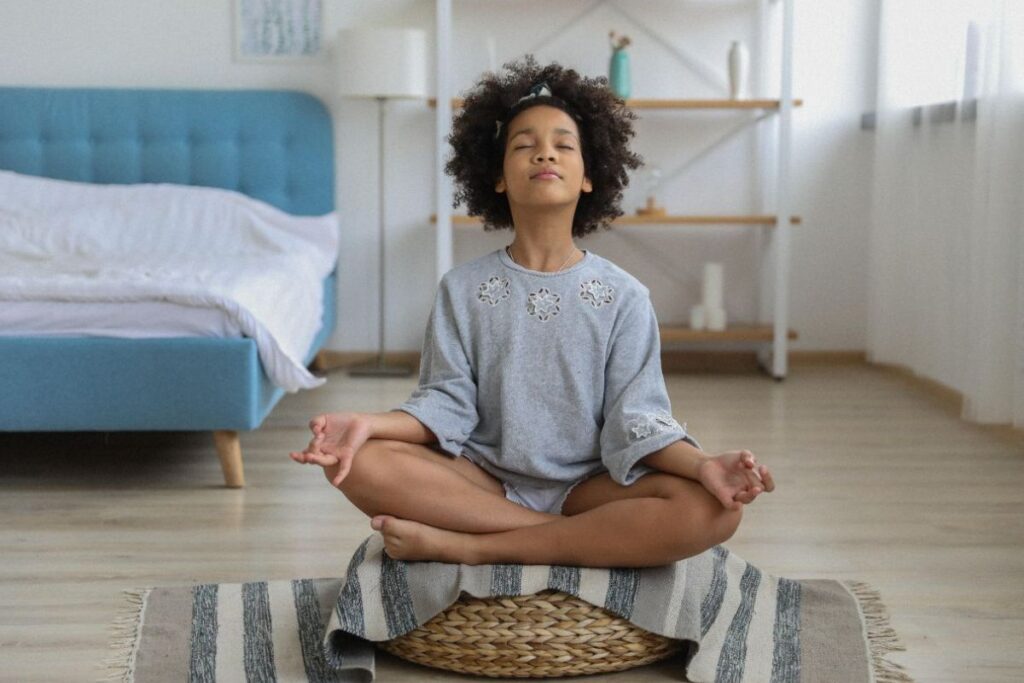
Meditation & Families
Meditation has several benefits for the mind and body – these benefits extend to children as well as adults. By encouraging your child to engage with meditation practices early on, you’re not only helping them in the present moment but you’re setting them up for a lifetime of healthy stress management. Studies show that meditation can help children with focus, self-awareness, self-regulation, general mental health, and more. This week, we are sharing a few simple ways to build meditation practices into your child’s routine; especially early on, we recommend trying different techniques to keep children engaged and to find what works best. Although you might alternate activities, we suggest keeping “meditation time” at the same time each day, perhaps first thing in the morning or right before bed.
Research on structured meditation programs for children and youth is suggestive of benefits, particularly related to improvements in mental health, coping, and self-regulation as well as decreasing hypertension and negative school behaviors. – American Academy of Pediatrics
Quiet Time
The first and simplest approach to meditation is to ask children to participate in quiet time. Set a timer on your phone for a short amount of time (a common suggestion is 1-minute for each year of the child’s age) and ask your child to close their eyes and be quiet during that time. Ask children to focus on their breath and their feelings; advise them to notice the way their emotions and body feel. When the timer goes off, have a conversation about how the time felt in your body and mind. For children new to this, you might offer a reward at the end of quiet time, such as playing a favorite game or similar.
Coloring
Coloring is actually a great active meditation. Although blank paper works well, we love these Mindful Coloring for Kids books that give children a place to start. The act of coloring is a slow, deliberate one that focuses the mind. Ask children to engage in a few minutes of quiet coloring then share their creations with you afterwards. You might try to increase the amount of quiet time by 15 or 30 seconds each time your child does this activity to give them a renewed sense of challenge and interest.
Guided Meditations
There are many guided meditations for children and families out there. Headspace for Kids has a variety of meditations for children at different ages and points in life. They offer basic morning and evening meditations, as well as those geared towards moments of stress or anger. We suggest setting the tone and making it part of your family ritual; perhaps the whole family meditates in the morning in a comfortable space before changing out of pajamas. Afterwards spend time over breakfast sharing anything you noticed during the meditation; as parents model how to use meditation and calmly communicate, children will follow suit. It’s important to highlight to children that meditation is one tool (of many) they can reach for when struggling with big feelings.

Singing Bowl
We love the idea of incorporating singing bowls into at-home meditations. This ancient tradition helps children learn to listen and focus. There are many available online; if you don’t have one, we love the Harmony Kids Co. version for littles ones and this lovely brass set from Simon Pearce for older children and adults. The blog Silent Mind has several ideas for how to use the bowl to practice mindfulness at home.
Floating
Next time your family is by the pool, take the time to build in a little meditative exercise amongst the summer fun. While you keep count (and a careful eye on little ones!), encourage your child to float on the water with their eyes closed, noticing how the water feels, how the sun feels on their skin. Even young children are often surprised by how much they enjoy a quiet moment amongst the excitement of a busy day.
Sky Gazing
On your next camping trip or time outdoors, have children lay on their backs in the grass and stare into the sky during quiet time. Let their eyes explore the stars and focus on their breath. This came be done on overcast days too. We love starting a family picnic or outdoor dinner with this quiet time to allow everyone a moment to reset; afterwards, everyone can share a nourishing meal together.
Further Resources
- Green Child: Guided Meditation for Kids: Benefits + Free Relaxation Scripts
- A Simple Guide to Sleep Meditation for Kids
- Cleveland Clinic: Meditation for Kids: The Basics and the Benefits
- Forbes: Science Shows Meditation Benefits Children’s Brains And Behavior
- Listen: Kids Meditation & Sleep Stories
- 5 Meditation & Mindfulness Activities for Families
Related Blog Posts
Mindfulness Book Recommendations for Children
Back to School: Rebuilding a Healthy Routine
